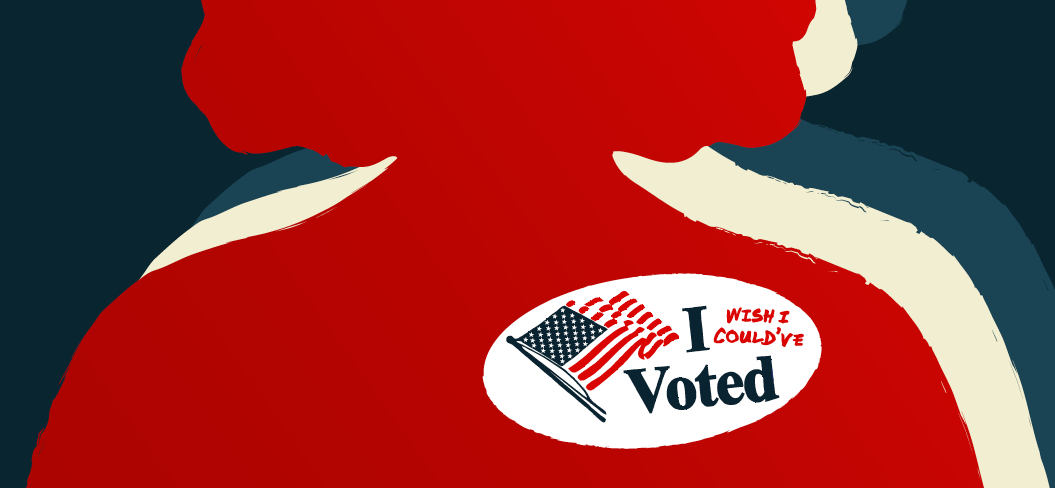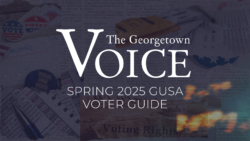Andrew Straky wants you to cast your ballot this November.
Straky (COL ’20) is a co-president of GU Votes, a program within the GU Institute of Politics and Public Service dedicated to getting Hoyas to vote.
“Following the 2016 cycle, we had over 90 percent voter registration among eligible students on campus, which is great,” Straky said. Nationally, 70.6 percent of eligible college students are registered to vote, according to a 2016 study by Tufts University. Despite this, Straky sees room for improvement in getting those registered voters at Georgetown to the polls, particularly when voting absentee. Each year, students face a variety of challenges submitting their ballots, which can leave them unable to participate in the electoral process.
In conjunction with the Office of Residential Living, GU Votes has set up an online portal where students can complete their absentee ballot request forms. They can then take their request forms to any RHO on campus, where GU Votes supplies stamped envelopes and a ballot request dropbox. The boxes’ contents are collected every night and mailed the next business day.
Straky emphasized that despite all of GU Votes’ efforts, there are limitations to what they can do. Most states require that absentee ballots be put directly in official mail boxes, not dormitory dropboxes. Straky recommends using the blue USPS collection boxes across from the front gates.
Before coming to Georgetown, Caroline Coopersmith (COL ’22) voted in-person in two elections in her hometown of College Station, Texas. After she tried to vote absentee this year, she described her frustration with the process: “I requested my ballot online, and they sent something to the address I gave them,” she said. “But once I opened it, I realized it was just a form saying, ‘I want my absentee ballot.’”
Once Coopersmith completed the form, she struggled to figure out what to do with it. The materials didn’t include the return address and wouldn’t fit in a prestamped envelope from GU Votes, so Coopersmith had to supply her own, which she didn’t immediately know where to find on campus.
Over the summer, a focus group of college students organized by the Fairfax County government concluded that many students don’t vote because they don’t know where to buy postage stamps to return their ballots.
Beyond stamps, several states also require students to get their absentee ballots or request forms notarized. There are several notaries on Georgetown’s campus, including in the GOCard office and the Business Office of the Planning and Facilities Management department in Harbin 103, both of whose services are available by appointment.
“I view requiring notarization of documents to vote as an undue burden,” Ray Shiu, associate director of the Georgetown Center for Social Justice, wrote in an email to the Voice. “Public notaries are allowed to charge up to $5.00 for each signature they notarize. I believe any financial barrier to voting is an undue burden on voters.”
But even meeting the requirements does not guarantee that a potential voter will be able to cast a ballot. Alexandra Rimoldi (MSB ’19) is from Las Vegas, Nevada. She requested her absentee ballot for the 2016 presidential election weeks in advance of the deadline.
“I was always ahead of it, I got the emails and everything to tell me what was going on and when the deadlines were,” she said. “I thought I had plenty of time. The election was coming up and I didn’t have my ballot in the mail, and I was thinking, well maybe it’s hard because the university with mail is always slow.”
But election day arrived, and Rimoldi still didn’t have her absentee ballot. Two weeks after the fact, it arrived in the mail. “I knew I had to get it early,” she said. “But I thought a month in advance was early enough.”
Sean Berman (SFS ’19), from Henderson, Nevada, had a similar experience trying to vote in the 2018 Democratic primary. He requested his ballot a month ahead of election day and had it sent to a former colleague’s D.C. residence to avoid using the university mail system. Berman confirmed through his county election department’s website that his ballot had been sent, but it never showed up in the mail. Both Berman and Rimoldi emphasized that their experiences voting absentee stood in stark contrast to their positive experiences voting in person at home.
Sam Seitz (SFS ’19), who is from Atlanta, Georgia, also had trouble getting a ballot during the 2016 election. “It was my first time being old enough to vote. I mailed in the request for an absentee ballot and just never received anything back,” Seitz said. “I don’t know what happened, I don’t know if it got lost in the mail, or I did something wrong.”
Seitz wasn’t able to vote in 2016.
Three states—Oregon, Washington, and Colorado—have implemented a system known as Universal Vote-by-Mail, or UVBM, which may ameliorate some problems with absentee voting. In those states, all registered voters receive a ballot in the mail which they can return either by mail or in person.
Phil Keisling, Oregon’s Secretary of State from 1991 to 1999, was the architect of the state’s system, and currently studies UVBM at Portland State University. His findings suggest that UVBM may help college students to vote. In a 2016 article in Washington Monthly, Keisling wrote, “In states with UVBM, turnout among younger voters (those from 18 to 34) is dramatically higher—double or more the rate in non-UVBM states.”
Hailing from Portland, Oregon, Cory Richardson (COL ’19) said that the state’s UVBM system means voting in state and voting absentee are nearly identical processes: “You fill out your ballot, and you stick a stamp on it, and you send it in from your house,” Richardson said. “They want to make it as easy as possible for someone to find time to vote.”
Students may also opt to vote locally. D.C. allows for same-day voter registration for all eligible voters, which includes Hoyas living on or around campus.
“If it’s 5:00 on election day and you want to vote, you can,” Straky said. “You need to provide proof of residence, which would be the one big barrier to Georgetown students, but you can get that from the registrar’s office if you live on campus. If you live off campus, you can take any utility bill or anything like that.”
The Georgetown neighborhood falls squarely in the sixth precinct, for which the local polling place is Duke Ellington High School, at the corner of 35th St. and Reservoir Rd. This is a change from 2016, when the polling place was the Georgetown Neighborhood Library.
Students headed to the polls in Georgetown should be prepared for it to take some time. In 2016, when Rimoldi hadn’t received her ballot by election day, she headed over to the Neighborhood Library to vote in the District—where she encountered a two-hour line.
Despite the difficulties, Straky believes that voting is one of the most important ways Georgetown students can effect change in the world. “If you want policy change on securing Second Amendment rights, or stricter environmental standards, your best way to do that is through voting. There are ballot initiatives all over the country that really do rest on the voice of the people,” he said.
“In a country where we still don’t have true suffrage for everyone where there are so many restrictions on voting, I think it’s important to exercise your right when you can.”





